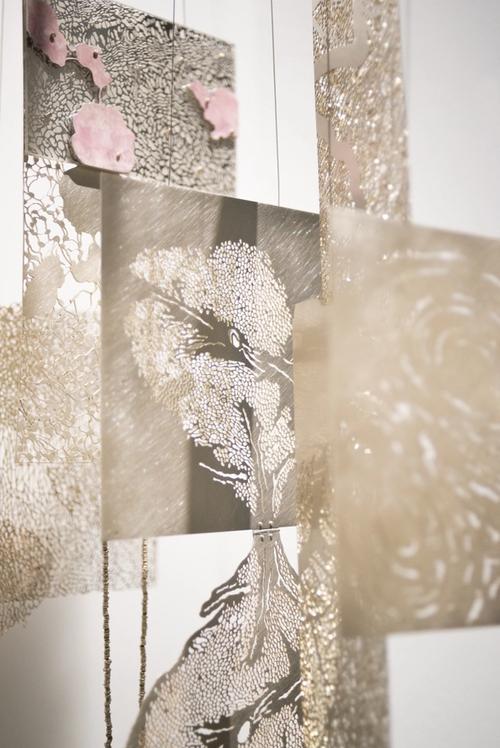Areas of Study
Metalsmithing & Jewelry
Program Description
In the Metalsmithing & Jewelry Program our four-year curriculum is designed to communicate the depth and breadth of our field, and to foster independent artists who can develop a distinct aesthetic expression.
Students experience multiple methods of making which include, soldering, casting, forming, forging, raising, fabrication, production design, enameling, stone cutting, arc welding, laser cutting, and the exploration of non-metal materials.
Life After Graduation
Our alumni are prepared for professions such as Bench Jeweler, Gallery Manager / Jewelry Store, Marketing & Sales Director / Jewelry Store, Program Director for an Art Organization, Industry Jewelry Designer, Independent Owner of a Jewelry Business, Studio Technician, Museum Display staff, Educator, Goldsmith, Blacksmith, Watchmaking Technician, and Robot Designer & Builder.
Spotlight
Faculty
Metalsmithing & Jewelry Faculty
Sample Courses
- MJ 101 Metalsmithing & Jewelry I
- MJ 212 Special Topics: Casting
- MJ 213 Special Topics: The Table
- MJ 217 Materials & Mechanisms Lab
- MJ 225 Design for Production
- MJ 233 Expressive Nature of Stone
Workspace & Tools
Elective Studio includes eight large worktables, four standard jeweler's benches equipped with handheld flex-shafts, demonstration table and flatscreen television, mini-drill press, large Bonny Doon 20-ton high speed electric hydraulic press, Durston 6” double rolling mill, Di-Acro 36” slip roll roller, Di-Acro 36” bending break, Di-Acro Di-Acro 12” precision hand shear, throatless beverly shear, four oxy-acetylene soldering torches, one oxy-propane mini-torch, two 12” and one 24" VCELLA enameling kilns, large variety of vitreous enamels, powder coating system, lapidary equipment including cabbing wheels, flat laps, and diamond blade saws, and a fully stocked metals and supply closet.
Forming Room includes four anvils, a wide variety of stakes and shaping mandrels, extensive collection of hammers and mallets, Durston draw horse, selection of forming stumps, 50lb iron swage block, small propane forge, large annealing torch, casting torch, VCELLA burnout kiln, Neycraft centrifugal casting machine, KayaCast vacuum investing and casting machine, ARBE wax injector, ARBE rubber mold vulcanizer, silicone mold equipment, ARBE bench top polishing machine with a range of buffing wheels and non-toxic polishing compound.
Machine & Chemical Room includes a JET bandsaw, JET combo 6” belt and 10” disc sander, stationary grinder, large drill press, sandblaster, lapidary saws and equipment, vibratory tumbler, and a selection of metal patinas and oxidizers.
Majors Studio includes a 24/7 private studio for each third and fourth year student equipped with their own standard jeweler’s bench and storage drawers, an industry grade Sunstone Micro TIG welder, four oxy-acetylene torches, Grizzly 10”x22” variable speed metal lathe, mini-drill press, chasing and repoussé pitch area, GRS standard jeweler’s block, selection of Jayne Redman Tools rotating bench pin system, and an extensive selection of industry standard communal tools which include Kate Wolf carving tools, miter-cutting vice and jigs, mandrels, hammers, jump-ring system, and a collection of various sized Durston forming and doming dap blocks. Majors studio includes an additional private photo room with photo lights, backdrop, and communal desktop Mac computer.
Challenged and supported by artist-educators, who are as passionate about teaching as they are about their own studio practices, you will: achieve the technical skills of soldering, fabrication, forming, raising, finishing, and fine goldsmithing in non-ferrous metals; learn the art of enameling, lapidary, and casting, and the language of the multiple; translate traditional skills into unexpected materials like wood, marble, plastics, and resin; link unorthodox connections to expand your craft; continue the tradition of holloware; and take your technical skills to an entirely new level by grappling with theory and entering the dialogue on craft as both noun and verb.
Jewelry majors have access to unparalleled facilities, equipment, and space to bring their visions to life. Our facilities are equipped for both jewelry making and traditional hollowware to ensure your path is supported with everything you need to succeed.
Learning Outcomes
Students will:
- Demonstrate an understanding of the expressive nature of both two- and three-dimensional form in relationship to the body.
- Employ technical skills with regard to traditional and contemporary metalsmithing and jewelry techniques.
- Employ formal design language, problem-solving skills, and critical thinking.
- Select applicable materials and choose appropriate techniques to develop a visual vocabulary in service to content.
- Demonstrate professional practices within the field of metalsmithing and jewelry.
- Employ knowledge about the history of metalsmithing and jewelry, contemporary theories and practice in their work.
- Speak critically about the metalsmithing and jewelry work of others from both historical and contemporary perspectives.
Course of Study
Foundation Year
Fall
- FN 101 Digital Imaging
- FN 109 3D: Materiality
- FN 113 Two-Dimensional Design
- Studio Elective
- EN 100 English Composition
- SEM 100 First Year Seminar
Spring
- DR 100 Introduction to Drawing
- FN 110 4D: Space & Temporality
- FN 108 Research & Inquiry – Studio
- SEM 108 Research & Inquiry – Academic
- AH 101 Art History Survey I
Sophomore
Fall
- MJ 101 Intro to Metalsmithing
- MJ 351 Introduction to the Discipline
- Studio Elective (Student Choice)
- AH 102 Art History Survey II
- Academic Elective
Spring
- Approved Studio Elective in Major
- Approved Studio Elective
- Studio Elective (Student Choice)
- AH 250 Critical Approaches to Contemporary Art
- Academic Elective
Junior
Fall
- MJ 301 Metalsmithing & Jewelry Majors Studio
- SEM 354 Junior Seminar: Craft Topics/Practice
- Approved Studio Elective
- Art History Elective
- Academic Elective
Spring
- MJ 302 Metalsmithing & Jewelry Majors Studio
- 2 Approved Studio Electives
- Art History Elective
- Academic Elective
Senior
Fall
- MJ 401 Metalsmithing & Jewelry Majors Studio
- SEM 451 Professional Studio – Craft
- Approved Studio Elective
- 2 Academic Electives
Spring
- MJ 402 Metalsmithing & Jewelry Majors Studio
- SEM 452 Senior Synthesis
- Approved Studio Elective
- 2 Academic Electives
Course Catalog Listing
Gallery

















